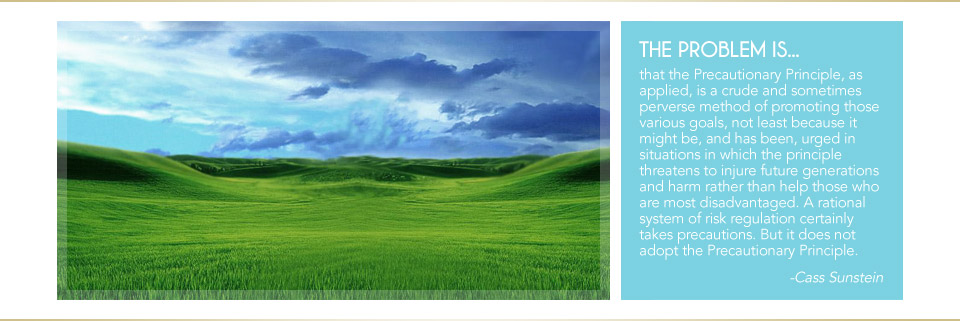Conclusion
“It is vain to provide for the needs of ages the technological abilities of which we cannot even dream”.-Ludwig Mises
The purpose of this website is to educate the reader of the less conspicuous side of the Precautionary Principle and Sustainable Development. Often environmental activists only tell the appealing side of both of these concepts. There are numerous versions of either concept and both are so vague that they would be easy to manipulate for a less than altruistic manner. The vagueness in both concepts has already been used in a manner other than its true intent. The two concepts even though they are current in use have been so for some time, have other serious flaws. Both concepts share a common bond in that quite a few of their flaws are shared between them.
One must wonder how it would be possible for two vague concepts can operate with any kind of efficiency on a global basis. The only logical conclusion is move to a globally central planning political system or perhaps a hybrid system which is a combination of central planning with restricted markets. It would be difficult for one country to exist in the sustainable area let alone a whole global economy.
With two concepts that are seriously flawed, what is the appeal behind using these two policies? There could be several reasons behind this:
■Both concepts give uncontrolled power to Judges and Regulators. Dr. Gary Marchant, author of the book Arbitrary and Capricious, who has this to say: "Proponents of the precautionary principle see power in its ambiguity. It gives regulators and courts unlimited discretion, and its ambiguity undermines transparency, accountability and fundamental principles of jurisprudence. Inevitably, the precautionary principle provides a shaky foundation for Europe’s legal decision-making. It will collapse on itself -- but not before it does serious harm to Europe’s economy and society.1" It has been suggested that proponents see that this principle is easily manipulative and that is another reason for its appeal among lawmakers. The Precautionary Principle is a necessary factor to go along with the concept of Sustainable Development. If you have Sustainable Development without the Precautionary Principle, regulator, judges, etc. lose much of their power over the process. When the Precautionary Principle is introduced into the equation, then the power shifts from the populace to regulator, judges, etc.
■Assuming a global centrally planned political system with Sustainable Development using the Precautionary Principle, these concepts could be utilized as tool to redistribute wealth to poorer nations. The Precautionary Principle has been utilized to block shipments of Genetically Modified Grain (GMO) to countries in Africa that were experience famine. The reasons for the blockage, GMO’s have the suspicion of being unsafe so therefore the Precautionary Principle was enacted. In this particular case, the World Trade Organization (WTO) even stated that there was no scientific evidence behind the blockage. It has been well documented in other cases that abuses have occurred at the hands of the Precautionary Principle. Let’s use the example of if the UN banned grain sales from the US to other parts of the world due to the Precautionary Principle (let’s assume some perceived problem with a pesticide utilized on the grain). The US would have a massive surplus of grain that it would be unable to sell and the rest of the world would be able to sell their grain at an artificially inflated price.
A current example of the United States moving towards the Precautionary Principle and Sustainable Development is with the House bill H.R. 5820-The Toxic Chemical Safety Act of 2010. When you read the component of the bill you can see indirect references towards both the Precautionary Principle and Sustainable Development concepts. Example of which are as follows:
■Establishes minimum data sets and testing for all chemical substances and mixtures.
■Requiring safety standard determinations in the pre-manufacture stage.
■Creates incentives for safer alternatives to existing chemicals.
■Requires EPA to cooperate in international efforts. Establishes procedures to be implemented if or when the United States becomes a party to international agreements on the regulations of chemical substances.
■EPA is not unreasonably encumbered by judicial review.
■Establishes an expedited process for EPA to review a chemical based upon the EPA administrator’s determination.
■Just to name a few items.
It should be noted that in the 119 page House bill that the words “precaution” or “precautionary” are never mentioned.
The bill would prove to be devastating to the chemical industry due to the massive increase in regulation and required test that would be necessary for all chemical that are currently in the marketplace. Since the current administration has more of a priority of keeping environmentalist happy than to allow the chemical industry and its workers prosper. There is already a growing trend that segments of the chemical industry are closing down in the United States and head towards friendlier countries like China. If this bill is passed into law in its current form, the chemical industry would incur huge cost expenditures that undoubtedly be passed down to the consumer.
The idea of having a sustainable society is a worthwhile goal but may prove to be impossible on the global scale due to differing cultures, political philosophies and economic structure not to mention serious flaws in both concepts.
|



